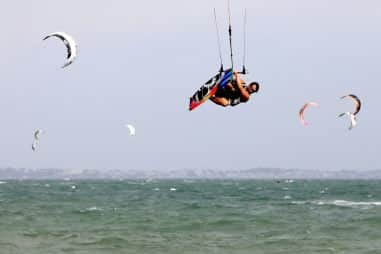Kiteboarding is the marriage of many watersports (surfing, wakeboarding, windsurfing, paragliding, and many more), all of them with varying degrees of risk. You must keep in mind that, as a beginner, you must learn the how-tos of the sport from a qualified instructor before venturing on your own.
How Do You Train for Kiteboarding?
As with any physical activity, it is best to always keep your body in tip-top shape to be able to successfully do a task. The same is true for kiteboarding. Kiteboarding training targets and develops your core strength, balance, stability, power, and coordination.
Basic kiteboarding training includes different exercises including lean back cable pistol squat, standing row, cable chest press, walking hip raises, plank, and side plank, among others.
While you can train your body in the comforts of your home, you can also ask for a personal trainer to customize your routine to help you train better. Proper training can help prepare your body for the activity.
Where Can I Learn Kiteboarding?
You can learn kiteboarding in all types of bodies of water provided that there is ample airspace for your kite.
While most kiteboarders prefer riding in oceans or bays, it is also possible to ride on rivers and even large lakes.
Can You Teach Yourself Kiteboarding Without Lesson?
Kiteboarding still remains as one of those activities that you cannot learn by yourself without actual professional lessons due to the risk posed by the sport itself.
While there are a lot of kiteboarding tutorial lessons on the internet today and it’s easy to DIY a lot of things, kiteboarding cannot be learned unless you get an instructor to help you with it.
How Much Do Kiteboarding Lessons Cost?
Kiteboarding lessons can be a little steep. On average, beginners spend anything between 500 to 800 dollars to get started on their lessons.
You can probably schedule lessons with a certified kiteboarding school or instructor who will only charge you per session. They also might just charge you for the specific lessons that you intend to learn.
Some kiteboarding schools offer private lessons for around 150 dollars per hour, while a fly and ride kiteboarding course can cost you 450 dollars. Some also offer a complete package for upwards of 1000 dollars.
Do I Need Kiteboarding Lessons?
The answer is a loud and resounding yes. Go and enroll yourself in kiteboarding lessons with a professional instructor. Remember that in kiteboarding, you get to do different extreme watersports all in one including surfing, windsurfing, wakeboarding, paragliding, and more.
You have to be able to do each activity to be able to successfully kiteboard. Aside from that, kiteboarding has a steep learning curve since it uses equipment that needs proper handling.
Sure, it’s fun to learn something on your own but kiteboarding is still a high-risk activity and remember that your safety should always come first.
Can You Kiteboard Alone?
It is not recommended to go kiteboarding alone regardless of your skill level. Remember that this is considered to be an extreme sport that may cause injury.
If you want to go out on a kiteboarding adventure, you should always bring a friend along. They will not only keep you company, but they will also be there to check your progress and, most importantly, your safety.
How Do You Kiteboard a Kite by Yourself?
While assisted launch is the recommended way to fly your kite, professional kiteboarders can be skilled enough to be able to successfully fly their kite.
But before we get to flying, you must keep these important things in mind:
- Only self-launch when the wind is light so make sure to always check the weather forecast.
- Study and familiarize yourself with your kite because different kites have different launching techniques
- Check if the area is clear. That means no obstruction of any kind including power lines, animals, and people nearby.
- You should have at least a 200-meter cone of clear airspace in the area where you will self-launch.
- It is not advisable to self-launch if you are upwind of the kite.
- Learn how to handle and pull the safety release and never grab the lines with your fingers
Now on to flying your kite:
- With the trailing edge facing the wind and the back of your kite on the sand, add sand on some spots on your kite to keep it still.
- Pump up and rig the kite. Make sure that the lines are positioned upwind.
- Turn your kiteboarding kite so that the leading edge is on a 45-degree angle across the wind.
- Make sure that the safety leash is connected.
- Properly hook your chicken loop into the harness.
- Turn so that your kite bar is on a 180-degree angle.
- Start to go backward slowly while you keep the tension on the lines.
- Carefully pull the high tip of the kite so that it catches the wind and takes off.
- As it flies, slowly ease the bar and let your kite reach the edge of the Wind Window.
How Long Does It Take to Learn Kiteboarding?
It’s hard to give a specific number of days or hours on how long someone can learn kiteboarding, but one thing’s for sure—it’s impossible to learn in a day. While it looks easy enough on videos, actually learning how to kiteboard requires a lot including patience, commitment, and hard work.
It also pays to have some kind of board skills and you must be comfortable enough in the water to help you learn faster. No matter how long it takes, if you are really committed to learning kiteboarding, you should continue all your lessons, train well, and practice, practice, practice!







